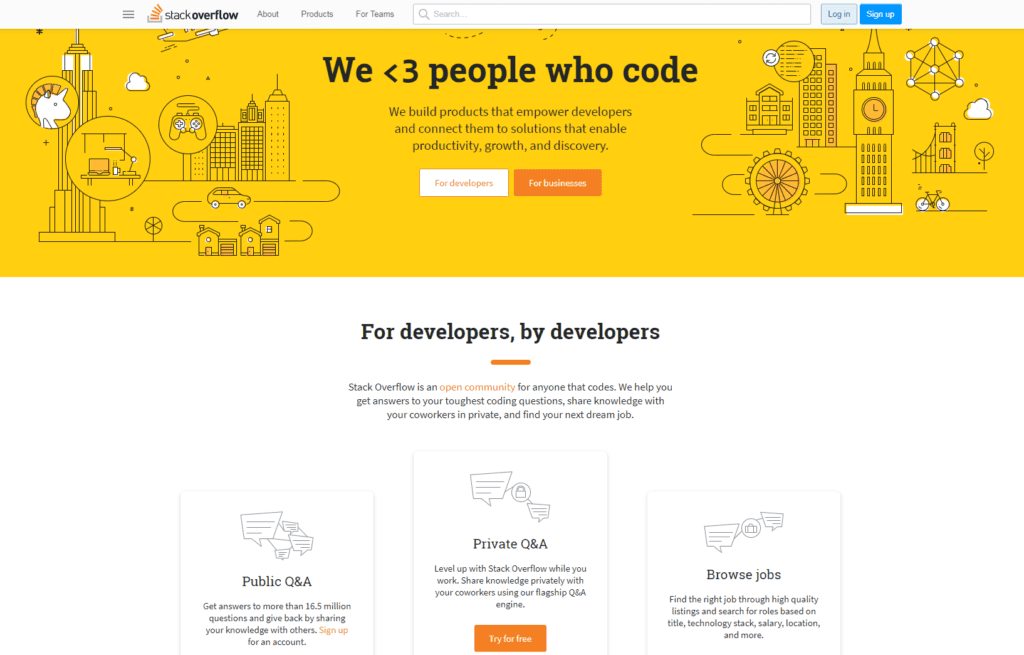Wie man eine Online-Community in 4 einfachen Schritten aufbaut

Inhalt
Das Internet ist für viele Dinge gut geeignet, aber am besten ist es, wenn es Menschen mit ähnlichen Interessen und Zielen zusammenbringt. Wenn Sie eine Online-Gemeinschaft von Gleichgesinnten aufbauen wollen, sei es aus persönlichen oder geschäftlichen Gründen, müssen Sie nur wissen, wo Sie anfangen sollen.
Der Aufbau einer starken Online-Community erfordert zwar etwas Zeit und Mühe, muss aber nicht schwierig sein. Man muss nur ein paar wichtige Details und Aufgaben beachten, z. B. die Zielgruppe recherchieren, einen zentralen Ort für ihre Interaktion schaffen und ihre Aufmerksamkeit gewinnen.
In diesem Beitrag werden wir die wichtigsten Schritte zur Schaffung einer florierenden webbasierten Community erläutern. Machen wir uns an die Arbeit!
Schritt 1: Recherchieren Sie Ihr Zielpublikum
Bevor Sie irgendetwas anderes tun können, müssen Sie die Menschen verstehen, die Sie zu einem Teil Ihrer Gemeinschaft machen wollen. Wahrscheinlich haben Sie ganz bestimmte Gründe, warum Sie eine Online-Community aufbauen wollen, aber um erfolgreich zu sein, müssen Sie sich in erster Linie auf deren Bedürfnisse konzentrieren.

Dies bedeutet eine gründliche Durchführung Recherche über Ihre Zielgruppe. Nehmen wir zum Beispiel an, Sie wollten eine Community für Lehrer aufbauen. Dies ist zunächst ein ziemlich breites Publikum, so dass Sie es vielleicht eingrenzen möchten, indem Sie sich z. B. auf Lehrer an Grundschulen konzentrieren.
Mit dieser Gruppe im Hinterkopf können Sie dann in die Recherche einsteigen, um so viel wie möglich über sie zu erfahren. Sie könnten versuchen, Fragen zu beantworten wie:
- Wie ist das Alter, das Geschlecht, die ethnische Zugehörigkeit usw. eines typischen Grundschullehrers?
- Woran sind diese Lehrer interessiert?
- Mit welchen Problemen sind sie konfrontiert, und/oder welche ihrer Bedürfnisse werden nicht erfüllt?
- Was erhoffen sie sich von der Zugehörigkeit zu einer Gemeinschaft mit anderen Lehrern?
- Wie sehen ihre derzeitigen Online-Gewohnheiten aus, und welche Plattformen nutzen sie bereits?
Die Antworten auf diese Fragen werden Ihnen viel darüber verraten, welche Art von Gemeinschaft Sie aufbauen wollen, wie sie strukturiert sein soll und so weiter. Vielleicht wissen Sie einige dieser Dinge bereits. Für das, was Sie nicht wissen, können Sie bestehende Online-Communities besuchen und Umfragen erstellen, Keyword-Recherche durchführenund vernetzen Sie sich bei persönlichen Veranstaltungen mit Ihrer Zielgruppe.
Schritt 2: Entscheiden Sie, welche Art von Gemeinschaft Sie aufbauen wollen
"Online-Community" ist eigentlich eine ziemlich vage Beschreibung. Er umfasst viele Arten von Websites. Bevor Sie Ihre eigene erstellen können, müssen Sie wissen, wie sie aussehen soll.

Einige der beliebtesten Optionen sind:
- Blogs. Dies ist die traditionellste Art der Online-Community. Sie können Inhalte erstellen und die Diskussion über Kommentare fördern. Alternativ können Sie Mitglieder einladen, einen Teil oder den gesamten Blog-Inhalt zu erstellen.
- Wikis. Ein Wiki ist ein unglaublich kollaborativer Raum, in dem viele Personen zusammenkommen und ihr Wissen bündeln können. Es ist ideal für Gemeinschaften, die sich mit komplexen oder datengesteuerten Bereichen beschäftigen.
- Foren und Diskussionsforen. In einem Forum haben Sie eine Gemeinschaft im reinsten Sinne. Die meisten sind in viele verschiedene Foren, Abschnitte und Themen unterteilt, in denen sich die Mitglieder kennenlernen und gegenseitig helfen können.
- Gamification-Plattformen. Gamification besteht darin, eine Aufgabe oder Aktivität spielerisch zu gestalten, um das Engagement zu fördern. Eine Fitness-Community könnte zum Beispiel von einer Website profitieren, die die täglichen Aktivitäten aufzeichnet und dann Punkte und Erfolge an die Mitglieder vergibt.
- Online-Kurse und Lernzentren. Ähnlich wie bei Blogs können Sie mit dieser Option in zwei Richtungen gehen. Sie können Kurse erstellen und laden Sie die Teilnehmer ein, gemeinsam zu lernen, oder laden Sie Ihre Mitglieder ein, ihr eigenes Wissen mit anderen zu teilen.
- Soziale Netzwerke. Es ist sogar möglich, ein eigenes soziales Netzwerk zu schaffen. Und es muss nicht unbedingt ein Facebook-ähnliches Unterfangen sein. Sie können ein kleines Nischennetzwerk aufbauen, das speziell auf die Bedürfnisse Ihrer Zielgruppe zugeschnitten ist.
Welche Art von Community-Website am besten geeignet ist, hängt weitgehend von Ihrer Zielgruppe und deren Bedürfnissen ab (wie oben beschrieben). Denken Sie aber daran, dass Sie nicht auf eine dieser Optionen beschränkt sind. Sie können zum Beispiel einen Blog mit einem Forum erstellen oder eine Website, die Gamification- und Social-Networking-Elemente kombiniert.
Schritt 3: Erstellen Sie Ihre Community-Website
Die meisten Online-Communities profitieren von einem zentralen Ort, an dem sich die Nutzer treffen und austauschen können. Das bedeutet, dass Sie eine eigene Website erstellen müssen. Wie diese aussehen wird, hängt von Ihren Entscheidungen in den beiden vorangegangenen Schritten ab.
Als Erstes müssen Sie sich für eine Plattform für Ihre Community-Site entscheiden. Es gibt viele Möglichkeiten, aber wir empfehlen dringend WordPress. Dieses Content-Management-System (CMS) ist einfach und kostenlos zu benutzen. Noch wichtiger ist, dass es Ihnen Zugang zu einer breiten Palette von Plugins gibt, mit denen Sie fast jede Art von Online-Community aufbauen können, die Sie sich vorstellen können.

Hier sind nur einige Beispiele für Instrumente, die Sie verwenden können:
- bbPress. Wenn Sie ein Forum oder ein Diskussionsforum erstellen möchten, ist diese Lösung einfach zu bedienen und dennoch sehr leistungsfähig.
- BuddyPress. Mit diesem Tool können Sie Ihr eigenes soziales Netzwerk aufbauen und Ihre Community dazu einladen.
- MemberPress. Dies ist ein flexibles Premium-Plugin, mit dem Sie alle Arten von mitgliedschaftsbasierten Community-Sites erstellen können. Sie können es sogar verwenden, um Online-Kurse unterrichten.
Wie Sie bei der Erstellung Ihrer Community-Site vorgehen, hängt von den Tools ab, die Sie verwenden möchten. Wie auch immer Sie vorgehen, vergessen Sie nicht, alle Informationen aufzunehmen, die Ihre Mitglieder benötigen. Das bedeutet, dass Sie neben den Community-spezifischen Funktionen auch Details zu Ihren Regeln und Richtlinien, Kontaktinformationen usw. bereitstellen müssen.
Schritt 4: Beginnen Sie, Ihre Gemeinschaft zu vergrößern
Wenn Sie Ihre Website erstellt haben, haben Sie ein gemütliches Zuhause für Ihre neue Community. Jetzt müssen Sie nur noch anfangen, Mitglieder zu gewinnen. Mundpropaganda kann zwar helfen, aber der beste Weg, um zu wachsen, ist, Ihre Online-Community direkt zu bewerben.

Zu den besten Methoden gehören:
- Optimieren Sie Ihre Website für Suchmaschinen. Google und andere Suchmaschinen können Ihnen eine Menge Besucher zuführen, solange Sie sie mit den richtigen Informationen zu versorgen.
- Erstellen Sie eine E-Mail-Liste und/oder einen Newsletter. E-Mail-Marketing ist ein hervorragendes Mittel, um neue Mitglieder zu gewinnen und bestehende Mitglieder zu informieren und zu engagieren.
- Beteiligen Sie sich an verwandten Gemeinschaften. Wir schlagen nicht vor, dass Sie versuchen, Mitglieder von konkurrierenden Communities abzuwerben. Suchen Sie stattdessen nach komplementären Communities - Mitglieder einer Fitness-Tracking-Site könnten an Ihren Online-Ernährungskursen usw. sehr interessiert sein.
- Bewerben Sie Ihre Gemeinschaft in den sozialen Medien. Ihre Publikumsforschung in Schritt 1 sollte Ihnen verraten haben, welche sozialen Plattformen Ihre Zielgruppe bevorzugt. Durch die Erstellung von Profilen auf diesen Plattformen und sich bemühen, zu posten und sich zu engagierentreffen Sie die potenziellen Mitglieder der Gemeinschaft dort, wo sie sind.
Und nicht zuletzt sollten Sie eine starke und konsistente Marke entwickeln. Je höher der Wiedererkennungswert ist, desto einprägsamer und ansprechender wird Ihre Online-Community sein.
Dazu gehören unter anderem verkürzte 'Pretty' Links erstellen die Sie in sozialen Medien, in relevanten Communities und in Ihren E-Mail-Newslettern teilen können. Auf diese Weise können Sie schnell und einfach Menschen dazu verleiten, sich durchzuklicken und Ihre neue Website zu besuchen.
Schlussfolgerung
Der Aufbau einer starken Online-Community braucht Zeit. Diese Investition kann sich jedoch eindrucksvoll auszahlen und zu einer Gruppe hoch engagierter Mitglieder führen, die sich für das interessieren, was Sie zu sagen haben.
Um Ihre Online-Community ins Leben zu rufen, müssen Sie nur Folgendes tun:
- Recherchieren Sie Ihr Zielpublikum.
- Entscheiden Sie, welche Art von Gemeinschaft Sie aufbauen wollen.
- Erstellen Sie Ihre Community-Website.
- Beginnen Sie, Ihre Gemeinschaft zu vergrößern.
Haben Sie Fragen zum Aufbau einer Online-Community-Website oder zur Verbreitung von Informationen über soziale Medien? Fragen Sie in den Kommentaren weiter unten!